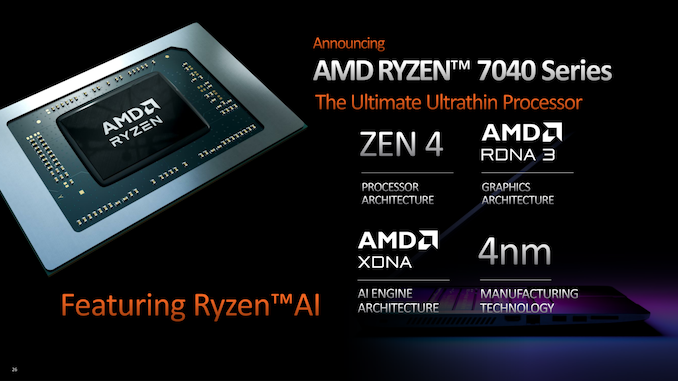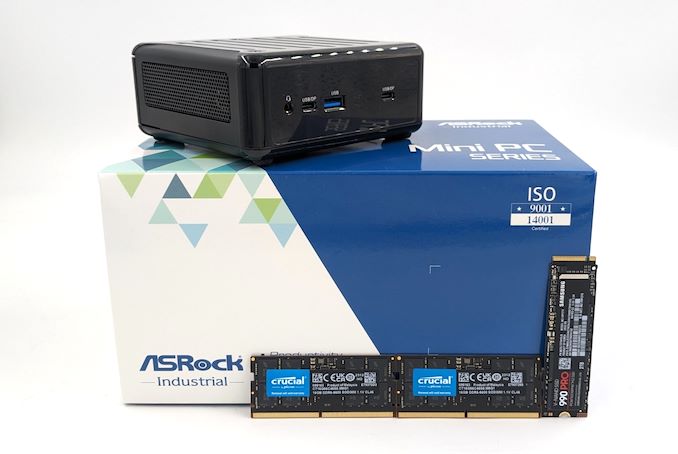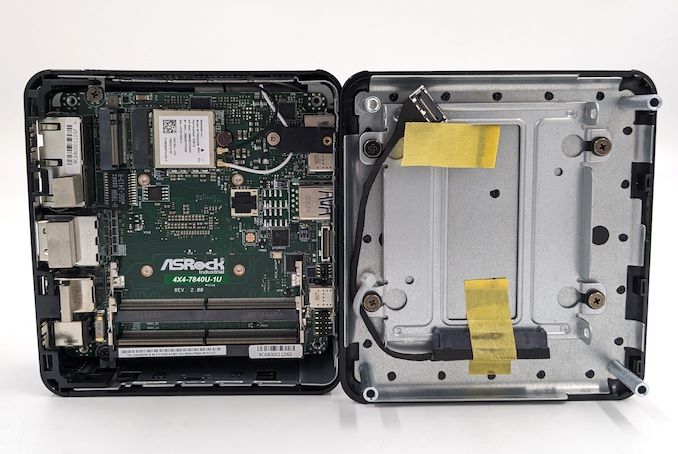ASRock Industrial 4X4 BOX-7840U mini-PC Review: AMD Phoenix in an UCFF Avatar
by Ganesh T S on December 28, 2023 8:30 AM EST
ASRock Industrial has been one of the most prolific vendors in the ultra-compact form-factor (UCFF) PC space over the last few years. They have been releasing 4"x4" systems based on the latest AMD and Intel platforms within a few weeks of their announcements by the processor vendors. On the AMD front, the company released the Rembrandt Refresh-based 4X4 BOX-7735U earlier this year, and followed that up a couple of quarters later with the Phoenix-based 4X4 BOX-7040 series.
The 4X4 BOX-7040 series builds upon the I/O and iGPU improvements in the 4X4 BOX-7735U with the incorporation of AMD's latest Zen 4 CPU cores and RDNA3-based iGPU. The move to a 4nm TSMC process (from the 6nm one used for Rembrandt Refresh) and the CPU / iGPU improvements should theoretically delivery much better performance and power efficiency for a range of workloads.
The Ryzen 7 7840U is a 28W TDP part that bears striking similarity to the Ryzen 7 7840HS that was already evaluated in a 65W mode in Beelink's GTR7. As a result of the lower power limit, the base clock is lowered. The iGPU configuration, I/Os, and other operating parameters remain the same. The U-series is primarily meant for notebook platforms, but ASRock Industrial (and other mini-PC vendors) have been deploying them in actively-cooled UCFF cases. The presence of a fan gives vendors a bit of leeway in configuring the power limits - and, as an extension, performance.
ASRock Industrial ships the 4X4 BOX-7840U in the 'Normal Mode' with AMD's suggested TDP of 28W. However, a toggle in the BIOS can push the system into a 'Performance Mode' with a souped-up TDP of around 40W. This review explores the performance profile of the PC in both modes, and provides detailed insights into the differentiating aspects of AMD's Phoenix in a UCFF mini-PC platform.
Introduction and Product Impressions
UCFF systems have been steadily replacing bulky tower desktops for many use-cases over the last decade. This category has been experiencing growth in both home consumer and industrial settings, with the latter prompting the B2B / industrial computing arms of many motherboard vendors to provide more attention to such systems. ASRock Industrial (spun out of ASRock's business unit in 2018) has been creating UCFF systems based on both AMD and Intel platforms since 2019.
This review delves in detail into the company's AMD Phoenix-based flagship UCFF offering - the 4X4 BOX-7840U. Based on AMD's high-end Phoenix 28W offering (Ryzen 7 7840U), the new system is meant to be a follow-up to the Rembrandt-R-based 4X4 BOX-7735U released earlier this year. The Ryzen 7 7840U continues with the same 8C/16T configuration of the Ryzen 7 7735U. However, the fabrication process has moved from TSMC's 6nm FinFET to 4nm FinFET, and the CPU cores are now based on Zen 4. The integrated GPU has also been re-architected, moving from the RDNA2-based Radeon 680M in Rembrandt-R to the RDNA3-based 780M in Phoenix.
ASRock Industrial's UCFF systems are non-descript machines that do not opt for a fancy case design. The functional chassis used in previous 4X4 BOX systems is retained for the 4X4 BOX-7840U also. This does mean an extension of the lifespan of the glossy polycarbonate fingerprint magnet casing, but that is set to change in 2024. The I/O port locations are exactly the same as in the previous generation. The internal board is also largely the same, as the USB4 ports and DDR5 support were already pencilled in during the design of the 4X4 BOX-7735U.
The company's 4X4 BOX-7040 series has only two members - one based on the Ryzen 5 7640U and the other based on the Ryzen 7 7840U. Some of the key relevant aspects are brought out in AMD's introductory slide to the product family back at the 2023 CES.
ASRock Industrial's choice of I/O ports for the Intel and AMD systems in the same generation is worth a note. While the rear USB ports are only USB 2.0 in the AMD ones, they are USB 3.2 Gen 2 in the Intel versions. However, the two front panel Type-C ports support the full USB4 feature set including PCIe tunneling in the AMD systems. The Intel boards are skimped on, with only one of the Type-C ports capable of full USB4 / Thunderbolt 4 support and the other falling back to USB 3.2 Gen 2 with Alt DP support.
The company offers both barebones version of the system as well as the motherboard alone. The former is typically sold in retail, while the motherboard is meant for the B2B channel. The barebones version package comes with a 120W DC power adapter (19V @ 6.32A), VESA mount (and associated screws), a geo-specific power cord, the main unit, and a product overview / user guide.
The barebones version needs two DDR5 SODIMMs and a M.2 2280 SSD to complete the build. Crucial's DDR5-5600 SODIMM kit (2x16GB) was complemented by a Samsung 990 PRO 2TB Gen 4 NVMe SSD for this purpose.
Access to the SODIMM and M.2 slots is via the underside, similar to the previous generation systems. Removal of the four screws at the bottom allows the panel to be popped off.
Despite the support for a 2.5" SATA drive in the system, ASRock Industrial strongly recommends not using it in order to aid with proper airflow. The installation process is otherwise similar to the older 4X4 BOX systems, and we were up and running with a freshly installed OS in no time (after installing the chipset drivers from the product support page). The Ryzen 7 7840U does include the XDNA engine (now rebranded as Ryzen AI in Phoenix Refresh), but the drivers for that (recognized as an IPU in Device Manager) are not yet available through Windows Update.
The full specifications of the review sample (as tested) are provided in the table below. As we will note in the next section, the BIOS allows the system to be configured in either of two modes with different TDPs, as specified in the Processor entry.
| Systems Specifications (as tested) |
||
| ASRock 4X4 BOX-7840U (Performance) | ASRock 4X4 BOX-7840U (Normal) | |
| Processor | AMD Ryzen 7 7840U Zen 4 (Phoenix) 8C/16T, 3.3 - 5.1 GHz TSMC 4nm, 16MB L3, 28W Target TDP : 40W |
AMD Ryzen 7 7840U Zen 4 (Phoenix) 8C/16T, 3.3 - 5.1 GHz TSMC 4nm, 16MB L3, 28W Target TDP : 28W |
| Memory | Crucial CT16G56C46S5.M8G1 DDR5-5600 SODIMM 46-45-45-90 @ 5600 MHz 2x16 GB |
Crucial CT16G56C46S5.M8G1 DDR5-5600 SODIMM 46-45-45-90 @ 5600 MHz 2x16 GB |
| Graphics | AMD Radeon 780M (RDNA3 / Phoenix) - Integrated (12 CUs @ 2.7 GHz) |
AMD Radeon 780M (RDNA3 / Phoenix) - Integrated (12 CUs @ 2.7 GHz) |
| Disk Drive(s) | Samsung SSD 990 PRO MZ-VP92T0B (2 TB; M.2 2280 PCIe 4.0 x4 NVMe;) (Samsung 7th Gen. V-NAND 176L (136T) 3D TLC; Samsung Pascal S4LV008 Controller) |
Samsung SSD 990 PRO MZ-VP92T0B (2 TB; M.2 2280 PCIe 4.0 x4 NVMe;) (Samsung 7th Gen. V-NAND 176L (136T) 3D TLC; Samsung Pascal S4LV008 Controller) |
| Networking | 1x 2.5 GbE RJ-45 (Realtek RTL8125BG) 1x GbE RJ-45 (Realtek RTL8111EPV) Mediatek MT7922 (RZ616) Wi-Fi 6E (2x2 802.11ax - 1.9 Gbps) |
1x 2.5 GbE RJ-45 (Realtek RTL8125BG) 1x GbE RJ-45 (Realtek RTL8111EPV) Mediatek MT7922 (RZ616) Wi-Fi 6E (2x2 802.11ax - 1.9 Gbps) |
| Audio | Realtek ALC256 (3.5mm Audio Jack in Front) Digital Audio with Bitstreaming Support over HDMI and Display Port (Type-C) |
Realtek ALC256 (3.5mm Audio Jack in Front) Digital Audio with Bitstreaming Support over HDMI and Display Port (Type-C) |
| Video | 2x HDMI 2.0 2x Display Port 1.4a over USB4 Type-C |
2x HDMI 2.0 2x Display Port 1.4a over USB4 Type-C |
| Miscellaneous I/O Ports | 2x USB 2.0 (Rear) 2x USB4 Type-C (Front) 1x USB 3.2 Gen 2 Type-A (Front) |
2x USB 2.0 (Rear) 2x USB4 Type-C (Front) 1x USB 3.2 Gen 2 Type-A (Front) |
| Operating System | Windows 11 Enterprise (22621.2861) | Windows 11 Enterprise (22621.2861) |
| Pricing | (Street Pricing on December 27th, 2023) US $570 (barebones) US $837 (as configured, no OS) |
(Street Pricing on December 27th, 2023) US $570 (barebones) US $837 (as configured, no OS) |
| Full Specifications | ASRock Industrial 4X4 BOX-7840U Specifications | ASRock Industrial 4X4 BOX-7840U Specifications |
In the next section, we take a look at the system setup and follow it up with a detailed platform analysis.















13 Comments
View All Comments
ingwe - Thursday, December 28, 2023 - link
Can the system be powered via one of the USB4 ports? I didn't see that noted but would much prefer that option. Particularly with the size of the power brick.meacupla - Thursday, December 28, 2023 - link
I doubt it. They have "USB/DP" labelled, but the lack of "/PD" is a sign that it most likely does not.TheinsanegamerN - Tuesday, January 2, 2024 - link
No, its wired to use the power brick for power input.kenyee - Thursday, December 28, 2023 - link
They should have made both Ethernet ports 2.5GB.Nice design otherwise....
meacupla - Thursday, December 28, 2023 - link
I'm kind of curious to know why they include a 120W power adapter when it only consumes 74W at full load.Do the 5x USB ports support 10W output each or something?
PeachNCream - Friday, December 29, 2023 - link
In this case 120W as a worst-case scenario with a bit of wiggle room seems reasonable especially when compared to nerds that routinely vastly overestimate their power supply needs and stuff a irrationally overspec PSU into the dinosaur-obsolete desktop form factor gaming/streaming/"esports" case.TheinsanegamerN - Tuesday, January 2, 2024 - link
USB 3 supports .9 amp per port, so 2.7 total, plus 1 for the 2 on the back. 3.7x5 is 18.5. 92.5 overall.Most off the shelf supplies are either 90, 120, or 135. So a 120 it is then. This also gives you headroom for capacitor aging and heat related power draw.
mode_13h - Thursday, December 28, 2023 - link
I don't see how they can pitch it as an industrial PC without ECC support (which I assume it lacks, since it wasn't mentioned).As a generic mini-PC, it does look like a good option, both in terms of multithreaded performance and efficiency. Too bad they didn't manage to close the gap with Intel's Raptor Lake-P NUCs, on idle power.
PeachNCream - Friday, December 29, 2023 - link
They're probably just using that in marketing materials so that retail/home buyers feel like they're getting something more reliable because its supposedly designed for industry usage. It's similar to how companies proclaim something is "off-road" to sell something to someone that might drive through their neighbor's yard or hit a curb at the grocery store. Also, if everyone does it, you can't be the vendor left out or people will ask, "Why does such-and-such not have a Sport Utility Vehicle Super Sport model? The word sport should be in the name or its not as good!"charlesg - Friday, December 29, 2023 - link
I agree with Peaches.It's basically marketing, which is mostly, um, using appealing terms, true or not.